![]()
![]()
![]()
Use LEFT and RIGHT arrow keys to navigate between flashcards;
Use UP and DOWN arrow keys to flip the card;
H to show hint;
A reads text to speech;
67 Cards in this Set
- Front
- Back
|
What three major factors does blood composition depend on?
|
Diet
Cellular metabolism Urinary output |
|
|
How many liters of blood plasma do the kidney's million nephrons filter per day from their glomeruli into the tubules??
|
150 L to 180 L
|
|
|
What occurs to blood plasma in the tubules?
|
It is selectively processed by tubular reabsorption and secretion
|
|
|
What is the average daily urinary output?
|
1-1.1.8 L
|
|
|
What is the normal color of urine and what is it due to?
|
Generally clear but oes from pale yellow to amber
Due to urochrome, a pigment metabolite arising from the body's destruction of hemoglobin via bilirubin or bile pigments |
|
|
What do color variations in urine indicate?
|
The relative concentration of solutes to water in urine
Greater the solute concentration, the deeper the color |
|
|
What is abnormal urine color due to?
|
Certain foods like beets, drugs, bile or blood
|
|
|
What is the odor of freshly voided urine vs urine left standing?
|
Freshly voided: aromatic
Standing: ammonia-like odor due to bacterial action |
|
|
What changes the odor of urine?
|
Some drugs, vegetables and disease processes
i.e. diabetes mellitus=fruity/acetone smell because elevated levels ketones |
|
|
What does the pH of urine range from and what is its average value?
|
4.5-8
Average value is 6.0, slightly acidic |
|
|
What changes the pH of urine?
|
DIET
Diet high in protein and wheat increases acidity (acid ash foods) Veggie diet (alkaline ash diet) increases the alkalinity Also BACTERIAL INFECTION=high pH |
|
|
What is specific gravity?
|
The relative weight of a specific volume of liquid compared with an equal volume of distilled water
Distilled water=1.00 |
|
|
What is urine's specific gravity range?
|
1.001-1.030
|
|
|
What do we call urine that has a specific gravity of less than 1.001?
|
Dilute urine
Contains few solutes Causes: too much water, use of diuretics, suffers from diabetes insipidus or chronic renal failure |
|
|
What are conditions that cause urine to have a high specific gravity?
|
Limited fluid intake, fever, kidney inflammation (pyelonphritis)
If the solutes precipitate, they form kidney stones (renal calculi) |
|
|
What are normal constituents of urine in order of decreasing concentration?
|
Water, urea, ions (sodium, potassium, phosphate and sulfate), creatinine, uric acid
Variable amounts (less) of calcium, magnesium and bicarbonate ions Abnormal amounts of any of this=pathology |
|
|
What are urea, uric acid and creatinine together?
|
The most important nitrogenous wastes in urine
|
|
|
What is urea?
|
An end product of protein breakdown
|
|
|
What is uric acid?
|
A metabolite of nucleic acid breakdown
|
|
|
What is creatinine?
|
Associated with muscle metabolism of creatine phosphate
|
|
|
What are some abnormal urinary constituents?
|
Glucose, albumin, ketone bodies, red blood cells, hemoglobin, bile pigments, white blood cells and casts
|
|
|
What is glycosuria?
|
Presence of glucose in urine
May result from excessive carbohydrate intake (temporary) |
|
|
What is pathologic glycosuria?
|
i.e. diabetes mellitus
Body cells are unable to absorb glucose from blood because of not enough insulin so body cells increase metabolism of fats, unusable glucose goes into urine |
|
|
What is albuminuria?
|
Presence of albumin in urine, a blood protein imp. in maintaining osmotic pressure of blood
Indicative of an abnormally increased permeability of the glomerular membrane (usually too large to pass through) |
|
|
What is a nonpathologic condition of albuminura?
|
Excessive exertion
Pregnancy Overabundant protein intake |
|
|
What is a pathologic condition of albuminura?
|
Damage of glomerular membrane (i.e. kidney trauma due to blows)
Ingestion of heavy metals, Bacterial toxins, glomerulonephritis and hypertension |
|
|
What is ketonuria?
|
the presence of ketone bodies (intermediates of fat metabolism) in excessive amounts
Expected in starvation; coupled with glycosuria fo diabetes mellitus; leads to acidosis |
|
|
What is hematuria?
|
The appearance of red blood cells in urine
Means pathology of the urine tract because RBC too large to go through glomerular pores Causes: irritation of urinary tract due to calculi, infections, physical trauma |
|
|
What is hemoglobinuria?
|
The presence of hemoglobin in the urine
Result of fragmentation, or hemolysis, of red blood cells Indicates hemolytic anemias, transfusion reactions, burns or renal disease |
|
|
What is bilirubinuria?
|
Appearance of bilirubin in urine
Indicates liver pathology (hepatitis or cirrhosis) Signaled by a yellow foam when urine is shaken |
|
|
Is urobilinogen normal or not in urine?
|
Normal in small amounts
Metabolite of bilirubin |
|
|
What is pyuria?
|
Presence of white blood cells or pus in urine
Indicates inflammation of urinary tract |
|
|
What are casts?
|
Hardened cell fragments flushed out of the urinary tract
Pyelonephritis: white blood cell casts Glomerulonephritis: red blood cell casts Fatty casts: indicate severe renal damage |
|
|
How did we determine specific gravity of the urine?
|
Used a urinometer float
Numbered lines give the reading for the first two decimal places, determine third place by reading the non-numbered line at the lower edge of the meniscus |
|
|
How did we determine the organic constituents in the urine?
|
Used a combination dip stick to take readings on several factors
--bilirubin, blood/hemoglobin, glucose, ketone bodies, nitrites, albumin, urobilinogen and WBCs should all be negative (urobilinogen sometimes trace) --need to be read during second minute otherwise invalid |
|
|
What is the normal color, clarity, odor, pH and specific gravity of urine?
|
Color: pale yellow
Clarity: transparent Odor: variable pH: 4.5-8 Specific gravity: 1.001-1.030 |
|
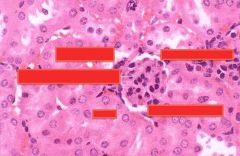
What is this?
|
Kidney
(Specifically zooming in on Bowman's capsule, 400x) |
|
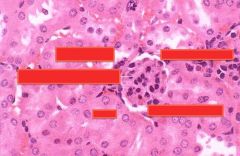
Label:
--Bowman's capsule --capsular space --glomerulus --parietal layer of capsule --renal tubule with simple cuboidal epithelium |
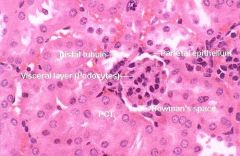
PCT and distal tubule=renal tubule for our purpose
Bowman's space=capsular space Visceral layer=glomerulus Bowman's capsule is the entire big thing |
|
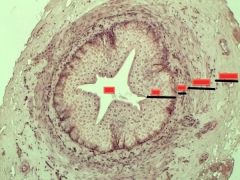
What is this?
|

Ureter, 100x
|
|

Label:
--lumen --transitional epithelium --lamina propria --smooth muscle --adipose |
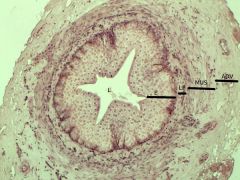
L=lumen
E=transitional epithelium LP=lamina propria M=Muscularis (smooth muscle) Adv=adventitia (adipose) |
|
|
What does the ureter do?
|
Brings urine from the kidneys to the bladder
|
|
|
What does the kidney do?
|
Where urine is produced.
|
|
|
What does the urethra do?
|
Allows urine to be eliminated from the body through this tube.
|
|
|
What does the urinary bladder do?
|
It's where urine is stored.
|
|
|
What is the name of the endocrine gland that lies on top of each kidney?
|
Adrenal gland
|
|
|
What is the name of the three structures that enter or exit the concave structure of the kidney at the renal hilus?
|
1. Ureter
2. Renal vein 3. Vena cava |
|
|
About how many nephrons are there in each kidney?
|
One million nephrons per kidney
|
|
|
What is the function of the nephrons?
|
Functional unit of the kidney
Responsible for reabsorption and secretion of various solutes such as amino acids (glutamate) |
|
|
What are the areas between the renal pyramids called and what is their function?
|
Columns of Bertin
Allows the cortex of the kidney to be better anchored Consists of blood vessels and urinary tubes |
|
|
What is the function of the renal pelvis?
|
Collects urine from pyramids and conveys into the ureter for passage into the urinary bladder
|
|
|
What is the pathway of forming urine within the juxtamedullary nephron?
|
Blood enters kidney from renal artery
1. Glomerular capsule (Bowman's capsule) 2. Proximal convoluted tubule (PCT) 3. Descending loop of Henle 4. Thick ascending loop of Henle 5. Early distal convoluted tubule (DCT) 6. Late distal convoluted tubule (DCT) 7. Cortical collecting duct 8. Medullary collecting duct |
|
|
What is the renal corpuscle made of?
|
Renal corpuscle made of Bowman's capsule and glomerulus
|
|
|
Does the filtration allow both small and large molecules to pass through?
|
Filtration driven by hydrostatic pressures
Only small molecules (like H2O) through, not large molecules (like proteins) |
|
|
What cell type lines the proximal convoluted tubules?
|
Epithelium, simple cuboidal epithelium
|
|
|
What is the function of the tight junctions between adjacent cells in the PCT?
|
Permits passage of water but limits the escape of large molecules from tubular lumen into interstitial space
|
|
|
Where is the juxtaglomerular apparatus?
|
Between vascular pole of renal corpuscle and tubule of the same nephron
|
|
|
What are the names of the two cell types present in the juxtaglomerular apparatus? What are they responsive to?
|
1. Macula densa cells
2. Juxtaglomerular cells |
|
|
What two cell types are found in the late DCT and cortical collecting duct?
|
Light cells -- most numerous
Dark cells -- only present in cortical region, H+ or bicarbonate |
|

What is in outlined in blue?
|
kidney
|
|

What is in outlined in blue?
|
bladder
|
|
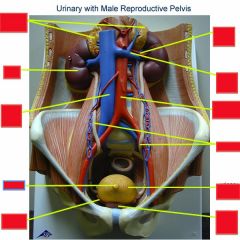
What is in outlined in blue?
|
Urethra
|
|
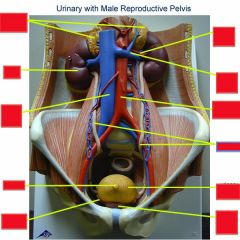
What is in outlined in blue?
|
Ureter
|
|
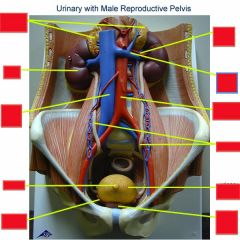
What is in outlined in blue?
|
Renal vein
|
|

|
Renal artery
|
|
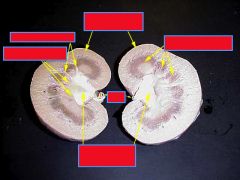
Label:
renal capsule, renal cortex, renal (medullary) pyramids; renal columns; renal pelvis; ureter |
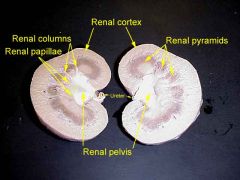
here
|
|

Label:
renal capsule, renal cortex, renal (medullary) pyramids; renal columns; renal pelvis; ureter |
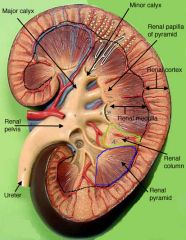
Here
|
|
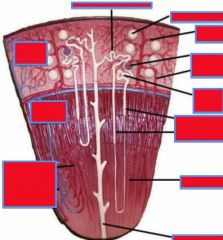
LABEL: afferent and efferent arterioles; glomerulus; Bowman's capsule; proximal convoluted tubule; descending and ascending loops of Henle; peritubular capillaries; distal convoluted tubule; collecting duct
|
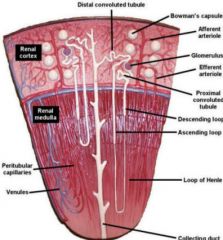
Here
|

